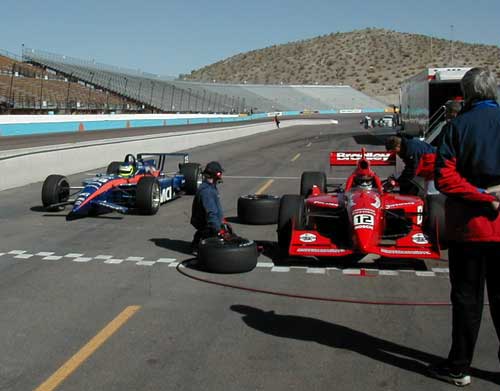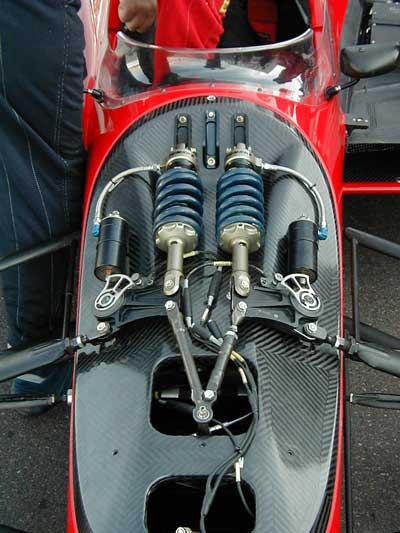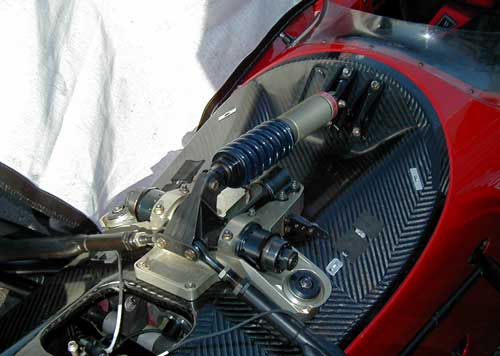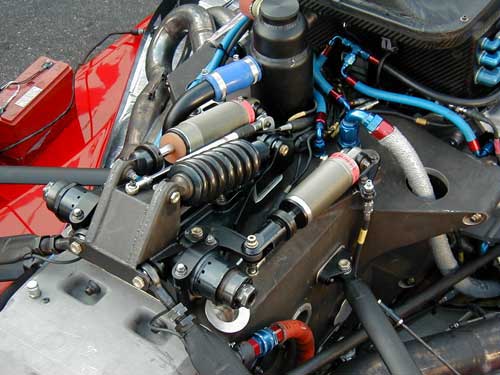
Return to the IRT Contents Page.

This page reports on two tests at Phoenix International Raceway near Phoenix, Arizona in February '99. CART cars don't race there anymore but the teams use it for winter testing. IRL cars shared the track during this first test. Jeff Braun, engineer for Buzz Calkins, emailed me these photos. This shot shows the difference between the short-track aero setups of the two series. The IRL rules use aero drag to slow the cars mandating a three-part rear wing that generates thousands of pounds of downforce. The front wing has to be cranked up to balance the car. The result is monster stick with a lot of aero drag. That means high speed in the corners, and low speed on the straights. One of the big problems the IRL cars have at Phoenix is power-on understeer coming off the corners.
(Added 3/2/99) A few days after I posted this page. I emailed Jeff and asked for some typical numbers for an IRL car at Phoenix. His return email said their top speed was 184 mph on the front straight. Minimum speed in Turn 1/2 was 161 mph and T 3/4 was 170.
In contrast to the IRL CART rules now specify the small speedway wings on short ovals. That's what you see on the MCI Reynard above. Compared to the IRL wings, the CART wings don't make much downforce, but the bottom of the CART car has small tunnels and makes much more downforce than the flat bottom on the IRL machine. The CART drivers are complaining about lack of grip in corners with the speedway aero specs, but they control the throttle don't they. Speeds on the straights are probably much higher than the IRL cars but corner speeds should be lower. There shouldn't be much difference in the tires between the two series.
The IRL car is a Dallara/Aurora and was driven by Buzz Calkins to a best lap time of 21.2 seconds. The CART car is a Toyota-powered Reynard driven by Christiano Da Matta to a best of 21.5 seconds. Both cars are on Firestone tires.

This is the front suspension of an IRL Dallara racecar. The pushrods act on the bell cranks to move the spring/damper coilover units. Notice the long distance between the center of the bell crank pivot and where the coilover bolts to the bell crank. Compare that to the distance between the bell crank pivot and where the pushrod bolts on. Coilover movement is multiplied by the ratio of these two distances. But the angle of the pushrod lowers the amount of coilover movement vs. vertical wheel movement. The result is the spring/shock unit moves about the same as the wheel, which is not much. Maybe only a tenth of an inch at the front and a half-inch at the rear. Go-karts? Yes. The tires are deflecting more than the suspension.
What else can we see in this photo?
The shocks are, of course, inside the coil springs. That's why the spring/damper units are called coilovers. These are Penske 3-way adjustable shocks. The hose coming out of the damper goes to the external reservoir. When the shock (They are really dampers but we call them shock absorbers or shocks, and I like to use both words for variety.) is compressed by a bump or chassis roll the shaft goes inside the body and displaces the hydraulic fluid which has to go somewhere. A monotube shock like a Bilstein or Koni has a floating piston that separates the oil from a gas that pressurizes the inside of the shock. That floating piston moves to allow the internal volume to expand as the shaft moves in and out.
In this shock the moving fluid goes through that hose to the external reservoir. Before it gets into the reservoir the fluid has to go past an an adjustable orifice and maybe a washer stack with adjustable blow-off. These two adjustments are common in remote-reservoir racing shocks. A floating piston inside the reservoir separates the oil from the pressurizing gas. The gas pressure prevents cavitation.
(What's cavitation? I explain that and a lot of other racing technical topics in the book Inside Racing Technology I wrote with Jeff Braun. For info on how to order the book go back to the IRT home page and click on the link to tvmotorsports.com.)
In the photo above the two links coming toward us forming a V go to the anti-roll device. We can't see it but at the bottom of the Vee is a blade mounted vertically inside the chassis. If the pushrods go up and down together as when both wheels go over a bump, this blade pivots freely forward and back, but when the car rolls the pushrods go in different directions and try to bend the blade. This adds roll resistance depending on how the blade is rotated. The adjustment that rotates the blade is driver controlled.
The wires go to a rotary sensor that is rotated by gear teeth on the outside of that shiny thing shaped like a shield with cutouts. The position of that sensor tells the on-board data acquisition system the position of that bell crank and therefore the suspension.
The nuts and locknuts on the top of the pushrods are a very accurate (+/- 0.002 in.) way to adjust ride height. The driver can feel very small adjustments in ride height because it effects the downforce the car produces and also the balance.

The photo above shows an alternate Dallara front suspension that uses only one coilover unit. When both the wheels move together in bump or rebound, the pushrods activate the rotating link that moves the spring/damper unit. Roll movement occurs when the pushrods move in different directions. When this happens that link has to slide on its shaft and those dark cylinders on that shaft house springs, probably belleville washers, that add roll stiffness. Under the coilover you can see a cockpit-adjustable blade that adds to the roll stiffness.
Monoshocks separate roll and bump forces better than the conventional system with two bell cranks and separate coilovers. Monoshock suspension could be very effective on oval tracks. The wires going to the pushrods probably carry signals from speed sensors in the front hubs.

The rear version of the mono suspension is more complicated. It's also a little beefier-looking isn't it. Higher forces back here. The spring and damper are not coilover but are mounted parallel. That makes for quicker changes. The extra damper to the right acts in roll only. The link to the roll damper has a pivot under the other spring. These are Koni 2812 shocks.
(Added 3/2/99) Jeff Braun told me total vertical movement at the rear is typically 0.875 in. max with the mono suspension. Total shuttle movement, side-to-side movement due to roll forces is only 0.075 in.
The shiny thing in between the spring and damper is a position sensor to measure suspension movement. There is another one under the roll damper to measure roll movement. That's the engine, of course, at the top right.

(Added 3/1/99) Jeff Braun sent me this photo after the IRL "Test in the West" Feb. 26 and 27. Here's his report:
Well today was very good until it wasn't..............
We ran in the AM working on a few things for speed. We did not have any new tires (Firestone was conserving them for the race weekend) so we ran on the two sets we had with 40 laps each. We could run 21.0 seconds with these all the way to 60 laps. We were the second fastest Firestone car again, so they "found" two new sets for us.
We did go 20.9 on a new set, but did not put the full qualifying set up on it. We were running heavy fuel, normal aero, and normal stagger.
After that we did long runs and ran in the heat of the day (track 120 deg). We got the car to run 21.1 seconds with 40 lap tires in the heat and Buzz did it lap after lap. We were very happy. We had 40 laps left on the engine before it had to come out for rebuild, so we went for one last long run.
On lap 10 the engine blew going into turn 3 and when the rods came out the side so did the oil. At 190 MPH entering a no-lift turn with oil on the rear tires, you crash. Buzz was OK but the left side was crushed. The tub is ok, gearbox, underwing, side pod, radiators, and suspension are not. Cost with engine about $140,000
So the Atlanta test next week is off. All the engines go back to Comptech. Next run will be the race March 28 at Phoenix.